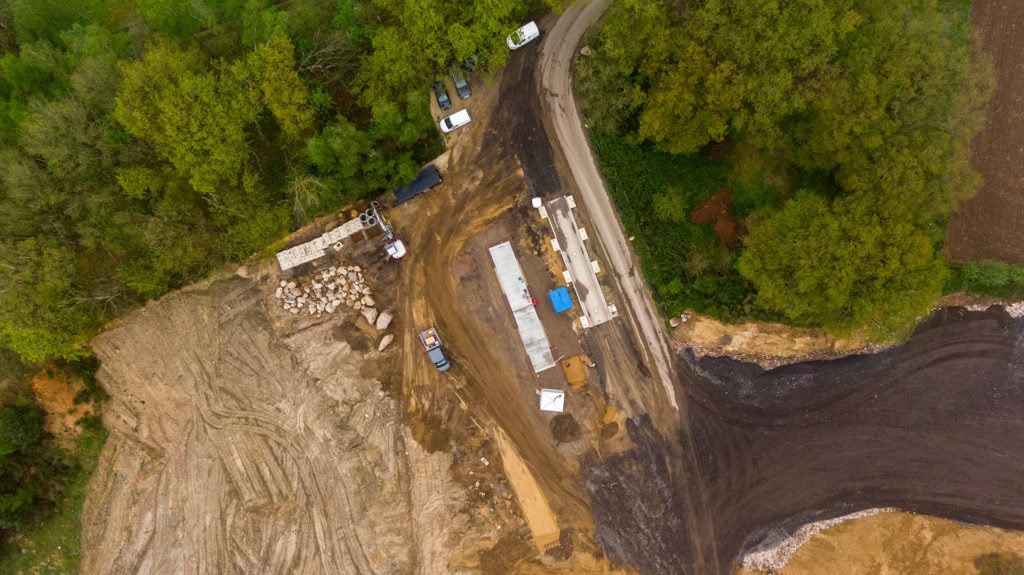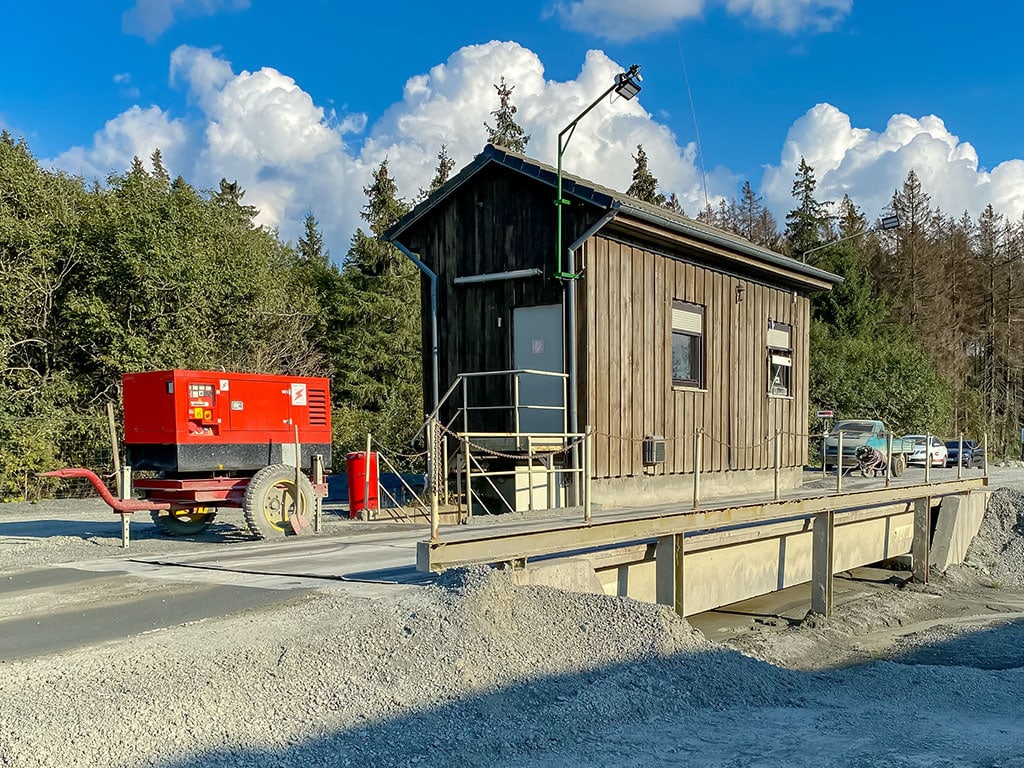You want to buy a truck scale?
This comprehensive buying guide will help you find the right truck scales for your location and purpose. Interesting to know: Truck scales are often also called weighbridges and sometimes also truck scales. Choosing the right truck scale depends on various factors, such as your budget, the space available, the frequency of use and the vehicles to be weighed. The extremely robust ESSMANN truck scaleswhich are designed to meet the high demands of use in harsh environments, can, for example, be loaded with vehicles with a gross weight of up to 60,000 kg, depending on the type.
When is a truck scale required?
A truck scale is required for business transactions. The following terms are relevant for this:
- Gross weight: the weight of the loaded truck
- Tare weight: Weight of the unloaded truck
- Net weight = gross – tare
The net weight is used, for example, to determine prices for the purchase or sale of goods, manage inventories or control processes.
A truck scale is also necessary for compliance with regulations (Road Traffic Licensing Regulations (StVZO) § 34 Axle load and gross weight ) . The maximum permissible weight of vehicle scales on public roads varies from country to country, but a common standard is 40 tons. The weight is usually calculated in two sizes:
- Axle weight – the weight carried by each axle
- Gross weight – the total weight of all axles
Truck scales can be used to ensure that the mass of the truck and/or the load on an axle is within the specified limits.
What types of truck scales are there?
Mobile steel truck scales
- Advantages: Flexible, easy to transport, can be set up without a crane and are quickly ready for use. Set-up scales are ideal for construction sites, mobile applications or temporary weight checks.
- Disadvantages: Higher space requirement compared to underfloor scales due to the ramps, more susceptible to weather influences.

Overhead truck scales
- Advantages: High accuracy, robust design, suitable for high loads, can be relocated.
- Disadvantages: Requires a flat surface, requires ramps, longer installation time.

Underfloor truck scales
- Advantages: Requires less space, can be driven over and does not interfere with the site as the scales are embedded in the ground.
- Disadvantages: Higher installation costs, less flexible than above-ground scales.

Decision criteria for the purchase of a truck scale
Configurations of the truck scales
In addition to the various weighing systems, there are at least three methods to determine the weight of a truck. Trucks can either be weighed by weighing each axle or wheel individually and then adding up the total at the end, which is cumbersome. Or they can be weighed in a single step, weighing the entire truck. This is faster, but requires larger scales.
It is possible to replace the one-stop method with dynamic weighing systems where the truck no longer has to stop. The weight of the truck is calculated as it drives over the truck scale.
- Single axle – In the most cumbersome method, a truck gradually drives over a single scale and stops each time a wheel set is on the truck scale. After all wheels or axles have been weighed, the total weight is added up.
- Total weighing – Either a series of individual wheel load scales or a large weighbridge are used so that the entire truck can be weighed at once. The scales are usually connected to a weighing terminal, which determines the gross weight.
- Weigh-in-motion (WIM ) – With this method, the weight per axle is calculated dynamically using a series of embedded sensors while the truck drives over the sensor surface. Unlike the other two methods, the truck does not have to come to a standstill on the scales. Some WIM systems are now installed on highways so that all traffic is monitored while the truck is moving.
Axle load scales are better suited for more flexible locations such as mining and construction, but also for campsites. Dynamic scales are best suited for weight management on highways. We offer portable axle load scales as well as stationary and dynamic scales for sale or for long-term rental on offer.

Weighing operations with one stop are better suited for stationary construction sites, large factories and farms.
Size and dimensions of the truck scale
The weighbridge must physically fit the footprint of the largest vehicle to be weighed. The vehicle size can of course vary, but it is important to think far into the future, because a high-quality weighbridge from ESSMANN | Waagen & Automation can last for several decades.
So if it is already planned to use larger vehicles in the distant future, the scale size should be designed accordingly. The weighbridges are available in standard sizes, but customer-specific dimensions are of course also available, such as with this steel scaleare also possible.
If an existing truck scale is to be replaced and the weighing pit is to be reused, the new scale should fit these dimensions. As a first step, ESSMANN | Waagen & Automation checks whether the existing scale can be modernized. existing scales can be modernized can be modernized. This is sustainable and saves costs and resources.
Length of the truck scale
A scale with a length of 10 m is usually sufficient for weighing smaller vans. If an entire truck needs to be weighed, the truck scale should be long enough to accommodate all the wheels of the longest truck to be weighed. This usually means a length of 18 or 20 m. In loading systems, the truck is usually moved on the scales to ensure that the loading area is filled evenly. A length of 24 – 30 m is usually ideal here.

The maximum overall length of tractor units and tractor trailers is usually specified by regional/state/provincial authorities. However, we can also manufacture longer scales on request.
Width of the truck scales
Typical truck scales are on average 3-3.5 m wide. A wider truck scale can make it easier to drive special vehicles onto the scale.
Steel or concrete truck scales?
When selecting the material for the truck scales, you can choose between steel and concrete surfaces. Both materials give the same weighing performance and both are designed and built to the same design specifications. However, there are some differences that may make one or the other material more advantageous for the truck scale in its location or application. Steel scales can be installed without cranes, concrete scales are usually even more durable. We would be happy to advise you on your choice!
Above-ground installation or ground-level installation of the truck scale?
You can choose between a pitless above-ground truck scale (HE-ÜWS above-ground truck scale) or a pit scale. A pit scale installed at ground level (HE-SFK underfloor truck scale) is installed in a pit to be constructed on site so that the surface of the weighing platform is flush with the asphalt.
Historically, all truck scales were installed in deep pits because mechanical lever mechanisms with large levers and suspension systems had to be accommodated. Today, these mechanical scales are obsolete and deep pits are optional.
Even if a pit is used, the depth requirements of a truck scale are not insignificant, as the depth of the pit can significantly affect maintenance and servicing procedures. This is because a pit that is too shallow creates little space for maintenance personnel, making maintenance more difficult.
Pitless scales or open edge overhead scales are built on one level and are suitable for a variety of industries such as construction, gravel pits, agriculture, biogas plants and waste management. They offer robust materials, high capacities and multiple dimensions for the specific requirements of these industries. Overhead truck scales can be open on one or both sides(overhead truck scales HE-ÜWS, mobile truck scales HE-TS).
The choice between pitless and pitless truck scales depends on local conditions. A scale installed above ground requires more space for the loading and unloading ramps, and these truck scales cannot be driven over crosswise.
Industry safety requirements may require a pit scale if the truck must not be exposed to the risk of falling off the edge of the scale. A pit is necessary if there are height restrictions, for example under silos or loading equipment.
If overhead filling systems are already in place and cannot be moved, a pit scale is usually necessary.
How should your truck scales be positioned?
One of the decisive factors for the placement of a truck scale is the number of trucks that are to be weighed daily. In the vast majority of cases, each truck is weighed twice – once loaded and once unloaded.
- Small commercial operations usually carry out 50 to 100 weighings per day. If not all trucks arrive at the same time, the need for parking and maneuvering is minimal. A single truck scale should be able to handle this volume well if traffic can flow over it in both directions. It should be ensured that there is also a bypass road around the weighbridge.
- Moderate volume operations typically perform 100 to 200 weighings per day. These businesses should first determine when these trucks will be arriving and departing, as they may require a parking/parking area. The queue at the scale should not extend onto public roads or highways. It may be possible to handle this volume with a single scale and a bypass if the traffic flow is manageable at peak times. However, two weighbridges can offer advantages and flexibility.
- High-volume operations typically have more than 200 weigh-ins per day. Planners at these sites should think in terms of traffic patterns (control lights and barriers, marked lanes, etc.) and not just a required parking lot. Two or more truck scales are required for these operations.
- If you expect to handle a significantly higher volume of traffic, more than two truck scales should also be considered. For maximum flexibility, the scales should be able to handle loaded or empty trucks from both directions. In addition, a sufficient bypass should be planned around the truck scales. In addition, our license plate recognition system and EWP weighing software can be used to implement a fully automated truck scale.

Layout drawing for the planning of truck scales
In the planning phase, a complete plan of the site should be drawn up and an average working day with a corresponding truck volume should be used. Typical questions in this phase are:
- Where do the trucks go when they arrive?
- Is there a queue (in one or both directions) to use the truck scale?
- Where do the trucks go after weighing?
- Is there enough space between the truck scales and the loading ramps for maneuvering?
- Is the turning radius of the largest vehicles taken into account?
- Are trailers required?
Then the “what if” situations for the truck scales should be considered:
- What happens if a scale breaks down during the day for maintenance or repair?
- What if there is a heavy snowfall or heavy rain?
- What happens if the capacity of the system is increased?
- What if the drivers have to wait before they can load or unload?
- What happens during the high season?
Checking the location of the scales
It is often helpful to check the selected location before breaking ground. This can be done with the help of traffic cones or other markings that indicate the intended location of the weighbridge and peripheral equipment (remote displays, traffic lights, etc.).
Truck test drives should then be carried out through the marked areas to check the layout for problems. Experienced truck drivers in particular can help here to assess the space for maneuvering.
Preparation for the maintenance of a truck scale
Spilled material, snow and ice, road mud, etc. under or around the truck scale can significantly affect its service life and performance. Installing a water hydrant or water connection near the truck scale can help with regular cleaning.
Mining and aggregate companies in particular often integrate washing lines for the tires of the trucks in front of the scales. With such an automatic washing line for cleaning the trucks in front of the scales, the amount of dirt, mud and gravel that falls off the trucks is significantly reduced. In the long term, this can extend the service life of the truck scales.
Mobile or stationary scales?
A truck scale may only be required temporarily on construction sites, when felling timber or when batching materials. Here, a mobile or temporary truck scale (HE-TS truck scales) is required.
Instead of a custom-made concrete foundation, mobile truck scales use a steel structure consisting of several modules that are bolted together. An HE-TS mobile truck scale from ESSMANN | Waagen & Automation consists of drive modules, weighing modules and ramps. The weighing modules contain the load cells on which the drive modules rest.
No crane is required for assembly. The parts can be positioned using a forklift truck. The mobile scales require simple site preparation. Only compacted earth or gravel or a layer of concrete is required. The customer is responsible for ensuring that the ground is prepared accordingly. Drawings and requirements are provided in good time for this purpose.
How does a truck scale work?
A truck scale consists of the following components:
- Foundation
- Weighbridge
- Load cells
- Weighing terminal
- Weighing software
- Peripheral components
- Terminal box
- Measuring cable
The foundations and weighbridges of the truck scales are made of steel, concrete or a combination of both.
However, the load cells used in truck scales are different and vary from manufacturer to manufacturer. Load cell systems are now the most commonly used measuring technology in truck scales.
Each load cell consists of a durable material, such as steel or aluminum, to which one or more strain gauges are attached or embedded. A strain gauge consists of a meandering wire (or wires) attached to a foil that transmits a weak electrical current. When the load cell is subjected to a load, the wire in the strain gauge is slightly stretched or compressed. The change in the wire results in a difference in resistance to the current flowing through it.
The signal from each cell is transmitted via a measuring cable to a cable box and from there to a weighing terminal, which measures the deviation of the current in each load cell and calculates the weight that the truck scale loads. The truck scales are of course available as calibrated scales due to the high-quality and calibratable components.
Specific product information and article no. of the accessories for the truck scales can be found on our company website or in our product data sheets.
Truck scales for filling
Some companies use truck scales as filling devices to fill exact product quantities into trucks. These companies will, for example, plan a filling system above the truck scales for this purpose. ESSMANN | Waagen & Automation will help you select the best configuration and scale accessories for optimum integration of the filling controller and the truck scale.
ESSMANN | Waagen & Automation finds a solution even in difficult local conditions, such as for this customer who was supplied with an extra-wide truck scale (18 m x 4.5 m). The customer has to drive his trucks backwards through a hall door to load them onto the scales. ESSMANN | Waagen & Automation installed this scale in 2004 and has looked after it ever since. The truck scales have been working reliably for over 18 years and the customer is satisfied.
Advice from the scale manufacturer
So there is a lot to consider before buying a truck scale. Our experienced scale manufacturer team is available throughout Europe to help you with both the decision-makingas well as with calibration, maintenance, modernization and repair of your truck scales. Please feel free to contact usif you have any further questions. We will be happy to help you.
Are you looking for a public weighbridge near you?
Perhaps our ESSMANN truck scale finder can help you: Find a truck scale near you here.







